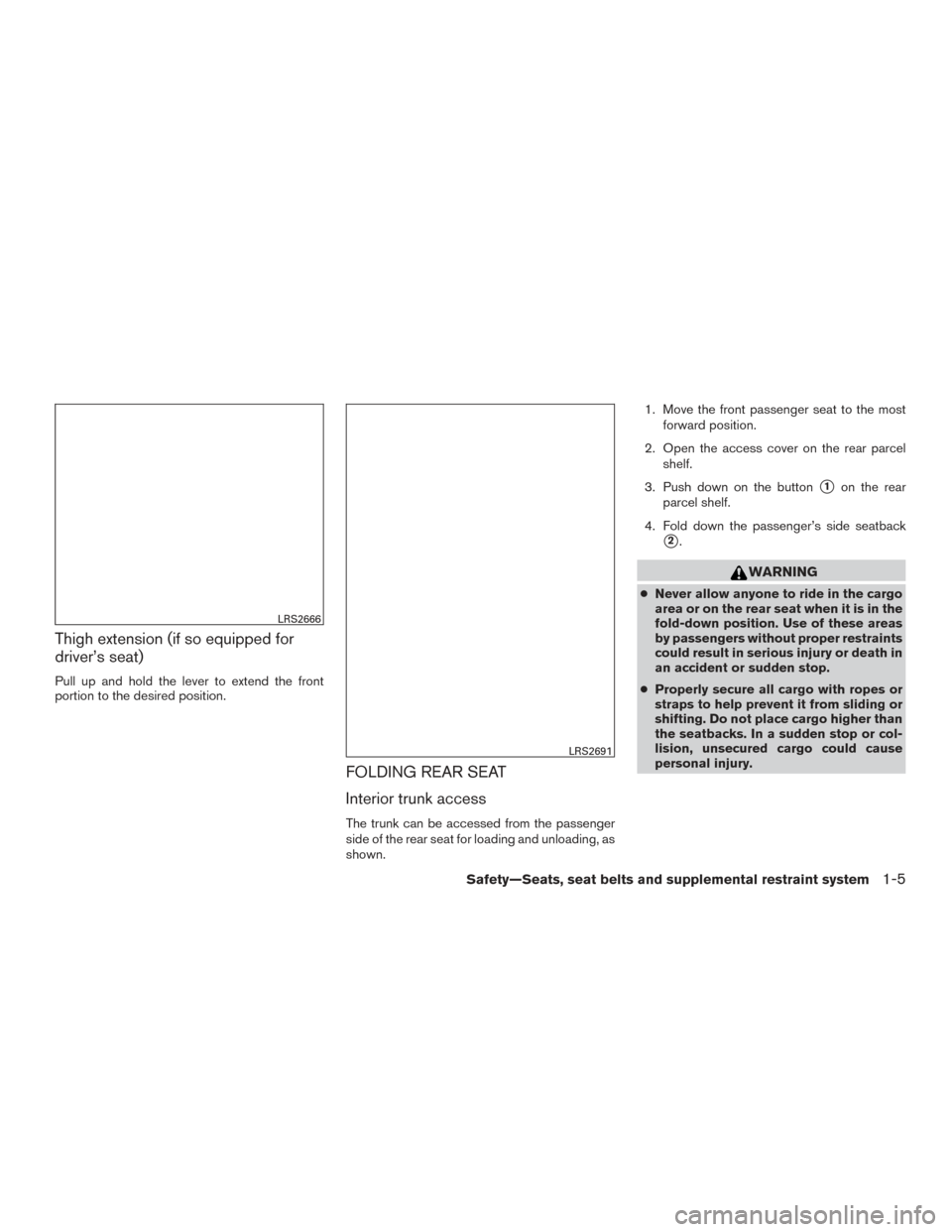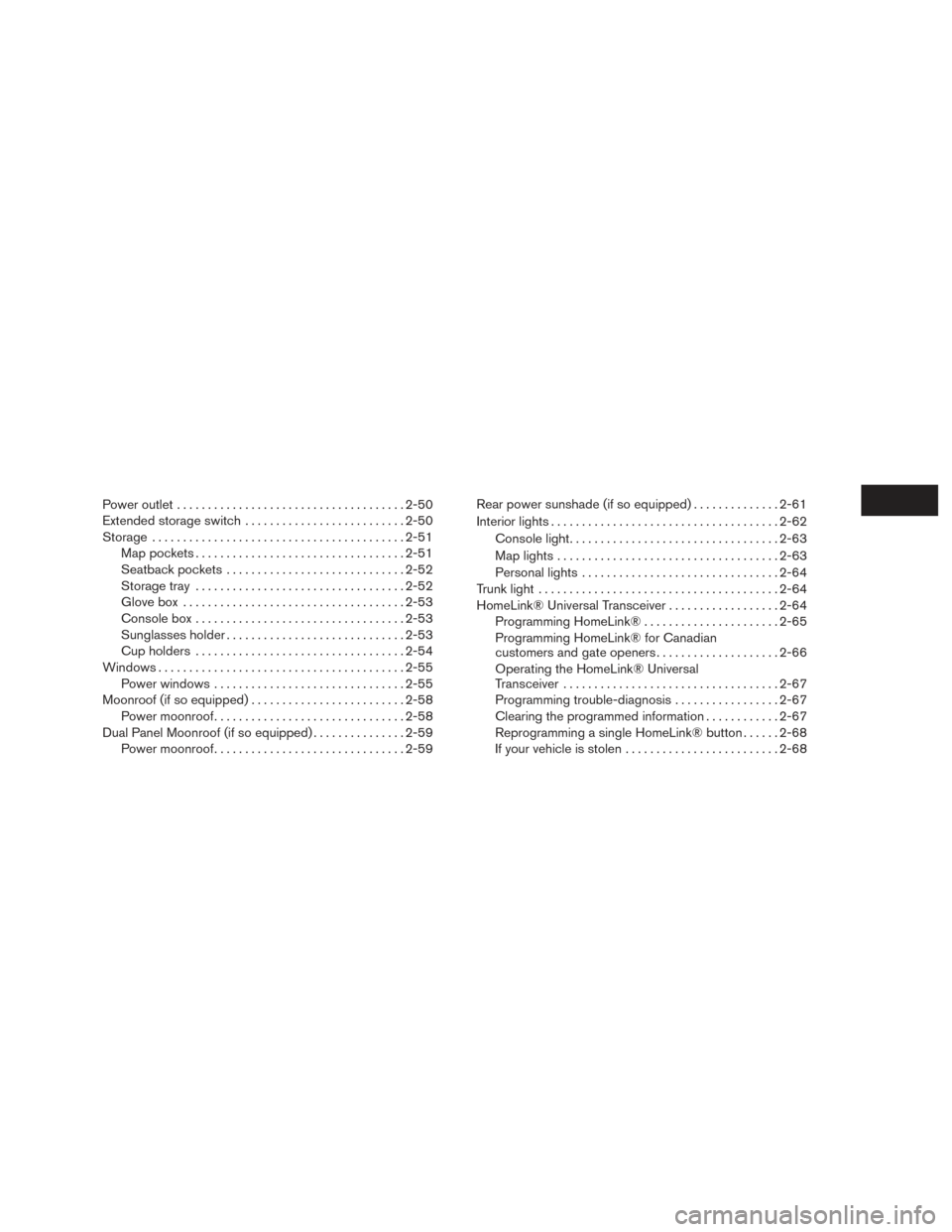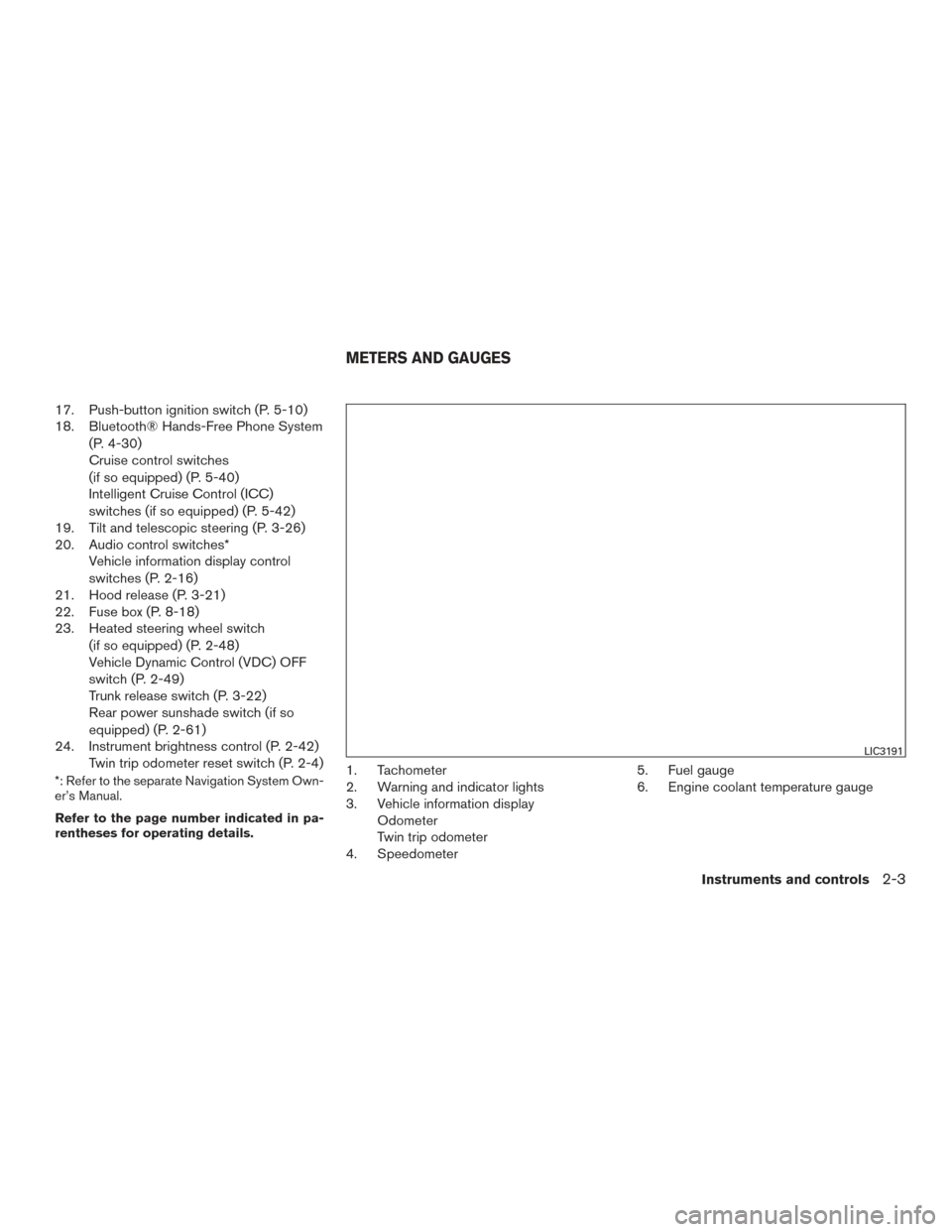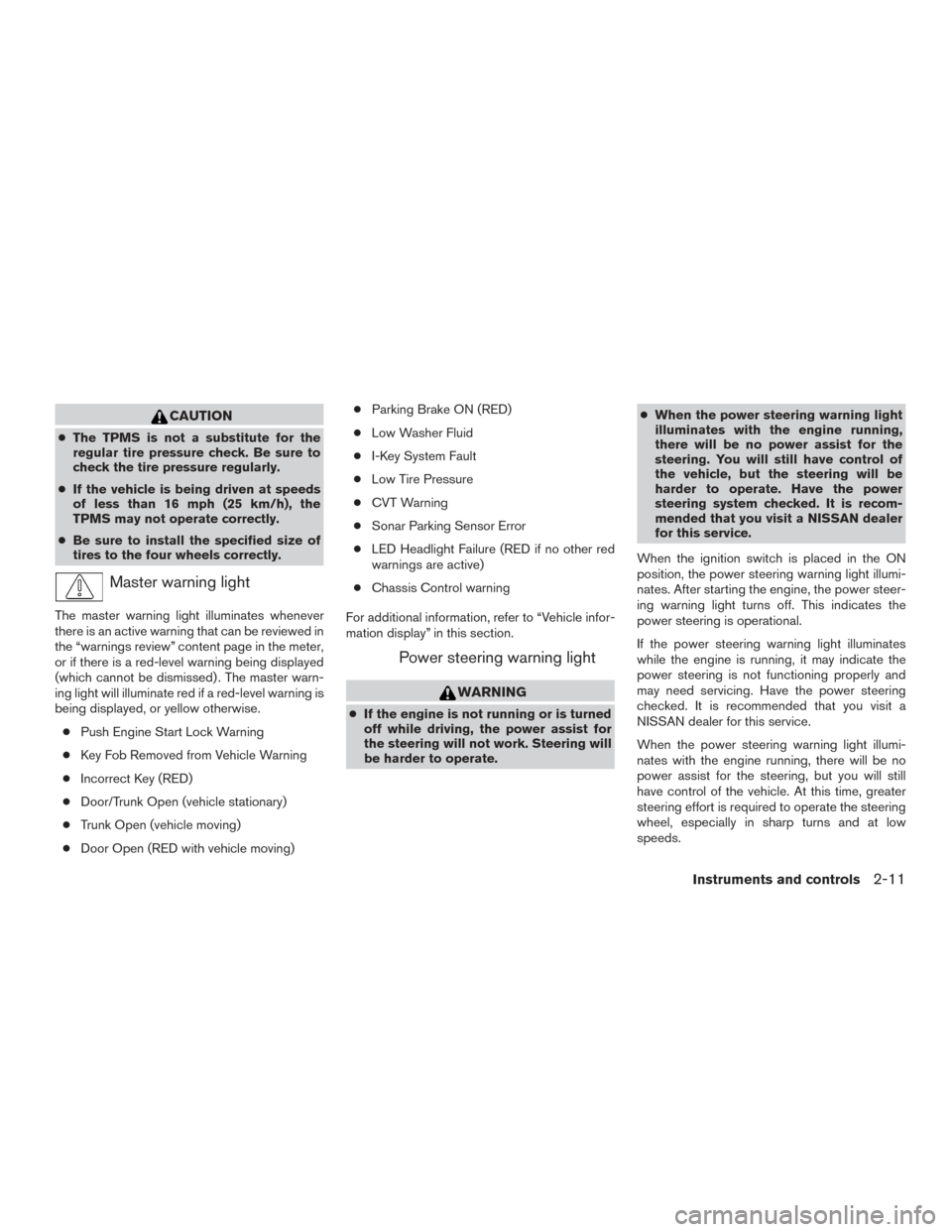Page 11 of 406
1. Rear window defroster switch (P. 2-41)
2. High-mounted stop light (P. 8-23)
3. Interior trunk lid release (P. 3-22)Trunk lid (P. 3-22)
4. Exterior trunk lid release/request button
(P. 3-7)
Rearview camera (P. 4-2, 4-9)
5. Rear sonar sensors (if so equipped)
(P. 5-85)
6. Replacing bulbs (P. 8-23)
7. Fuel-filler door (P. 3-24) Fuel recommendation (P. 10-2)
8. Child safety rear door locks (P. 3-4)
Refer to the page number indicated in pa-
rentheses for operating details.
LII2443
EXTERIOR REAR
0-4Illustrated table of contents
Page 12 of 406
1. Interior trunk access (P. 1-2)
2. Power moonroof (if so equipped)(P. 2-58, 2-59)
3. Sun visors (P. 3-28)
4. Map lights (P. 2-62)
5. Rearview mirror (P. 3-29) HomeLink® Universal Transceiver
(P. 2-64)
6. Glove box (P. 2-51)
7. Cup holders (P. 2-51)
8. Console box (P. 2-51)
Refer to the page number indicated in pa-
rentheses for operating details.
LII2444
PASSENGER COMPARTMENT
Illustrated table of contents0-5
Page 14 of 406
17. Push-button ignition switch (P. 5-10)
18. Bluetooth® Hands-Free Phone System(P. 4-30)
Cruise control switches
(if so equipped) (P. 5-40)
Intelligent Cruise Control (ICC)
switches (if so equipped) (P. 5-42)
19. Tilt and telescopic steering (P. 3-26)
20. Audio control switches* Vehicle information display control
switches (P. 2-16)
21. Hood release (P. 3-21)
22. Fuse box (P. 8-18)
23. Heated steering wheel switch
(if so equipped) (P. 2-48)
Vehicle Dynamic Control (VDC) OFF
switch (P. 2-49)
Trunk release switch (P. 3-22)
Rear power sunshade switch
(if so equipped) (P. 2-61)
24. Instrument brightness control (P. 2-42) Twin trip odometer reset switch (P. 2-4)
*: Refer to the separate Navigation System Own-
er’s Manual.
Refer to the page number indicated in pa-
rentheses for operating details.
Illustrated table of contents0-7
Page 22 of 406

Thigh extension (if so equipped for
driver’s seat)
Pull up and hold the lever to extend the front
portion to the desired position.
FOLDING REAR SEAT
Interior trunk access
The trunk can be accessed from the passenger
side of the rear seat for loading and unloading, as
shown.1. Move the front passenger seat to the most
forward position.
2. Open the access cover on the rear parcel shelf.
3. Push down on the button
�1on the rear
parcel shelf.
4. Fold down the passenger’s side seatback
�2.
WARNING
● Never allow anyone to ride in the cargo
area or on the rear seat when it is in the
fold-down position. Use of these areas
by passengers without proper restraints
could result in serious injury or death in
an accident or sudden stop.
● Properly secure all cargo with ropes or
straps to help prevent it from sliding or
shifting. Do not place cargo higher than
the seatbacks. In a sudden stop or col-
lision, unsecured cargo could cause
personal injury.
LRS2666
LRS2691
Safety—Seats, seat belts and supplemental restraint system1-5
Page 23 of 406
●When returning the seatbacks to the
upright position, be certain they are
completely secured in the latched posi-
tion. If they are not completely secured,
passengers may be injured in an acci-
dent or sudden stop.
● Closely supervise children when they
are around cars to prevent them from
playing and becoming locked in the
trunk where they could be seriously in-
jured. Keep the car locked, with the rear
seatback and trunk lid securely latched
when not in use, and prevent children’s
access to car keys.
To fold down the driver side of the rear seat, open
the trunk and pull on the strap
�1.
The rear seats can be locked using the mechani-
cal key to prevent unauthorized access. For ad-
ditional information on keys, refer to “Interior trunk
access” in the “Pre-driving checks and adjust-
ments” section of this manual.CENTER ARMREST
Pull the armrest down until it rests on the seat
cushion.
LRS2168LRS2694
1-6Safety—Seats, seat belts and supplemental restraint system
Page 80 of 406

Power outlet..................................... 2-50
Extended storage switch .......................... 2-50
Storage ......................................... 2-51
Map pockets .................................. 2-51
Seatback pockets ............................. 2-52
Storage tray .................................. 2-52
Glove box .................................... 2-53
Console box .................................. 2-53
Sunglasses holder ............................. 2-53
Cup holders .................................. 2-54
Windows ........................................ 2-55
Power windows ............................... 2-55
Moonroof (if so equipped) ......................... 2-58
Power moonroof ............................... 2-58
Dual Panel Moonroof (if so equipped) ...............2-59
Power moonroof ............................... 2-59Rear power sunshade (if so equipped)
..............2-61
Interior lights ..................................... 2-62
Console light .................................. 2-63
Map lights .................................... 2-63
Personal lights ................................ 2-64
Trunk light ....................................... 2-64
HomeLink® Universal Transceiver ..................2-64
Programming HomeLink® ......................2-65
Programming HomeLink® for Canadian
customers and gate openers ....................2-66
Operating the HomeLink® Universal
Transceiver ................................... 2-67
Programming trouble-diagnosis .................2-67
Clearing the programmed information ............2-67
Reprogramming a single HomeLink® button ......2-68
If your vehicle is stolen ......................... 2-68
Page 82 of 406

17. Push-button ignition switch (P. 5-10)
18. Bluetooth® Hands-Free Phone System(P. 4-30)
Cruise control switches
(if so equipped) (P. 5-40)
Intelligent Cruise Control (ICC)
switches (if so equipped) (P. 5-42)
19. Tilt and telescopic steering (P. 3-26)
20. Audio control switches* Vehicle information display control
switches (P. 2-16)
21. Hood release (P. 3-21)
22. Fuse box (P. 8-18)
23. Heated steering wheel switch
(if so equipped) (P. 2-48)
Vehicle Dynamic Control (VDC) OFF
switch (P. 2-49)
Trunk release switch (P. 3-22)
Rear power sunshade switch (if so
equipped) (P. 2-61)
24. Instrument brightness control (P. 2-42) Twin trip odometer reset switch (P. 2-4)
*: Refer to the separate Navigation System Own-
er’s Manual.
Refer to the page number indicated in pa-
rentheses for operating details.1. Tachometer
2. Warning and indicator lights
3. Vehicle information displayOdometer
Twin trip odometer
4. Speedometer 5. Fuel gauge
6. Engine coolant temperature gauge
LIC3191
METERS AND GAUGES
Instruments and controls2-3
Page 90 of 406

CAUTION
●The TPMS is not a substitute for the
regular tire pressure check. Be sure to
check the tire pressure regularly.
● If the vehicle is being driven at speeds
of less than 16 mph (25 km/h), the
TPMS may not operate correctly.
● Be sure to install the specified size of
tires to the four wheels correctly.
Master warning light
The master warning light illuminates whenever
there is an active warning that can be reviewed in
the “warnings review” content page in the meter,
or if there is a red-level warning being displayed
(which cannot be dismissed) . The master warn-
ing light will illuminate red if a red-level warning is
being displayed, or yellow otherwise.
● Push Engine Start Lock Warning
● Key Fob Removed from Vehicle Warning
● Incorrect Key (RED)
● Door/Trunk Open (vehicle stationary)
● Trunk Open (vehicle moving)
● Door Open (RED with vehicle moving) ●
Parking Brake ON (RED)
● Low Washer Fluid
● I-Key System Fault
● Low Tire Pressure
● CVT Warning
● Sonar Parking Sensor Error
● LED Headlight Failure (RED if no other red
warnings are active)
● Chassis Control warning
For additional information, refer to “Vehicle infor-
mation display” in this section.
Power steering warning light
WARNING
● If the engine is not running or is turned
off while driving, the power assist for
the steering will not work. Steering will
be harder to operate. ●
When the power steering warning light
illuminates with the engine running,
there will be no power assist for the
steering. You will still have control of
the vehicle, but the steering will be
harder to operate. Have the power
steering system checked. It is recom-
mended that you visit a NISSAN dealer
for this service.
When the ignition switch is placed in the ON
position, the power steering warning light illumi-
nates. After starting the engine, the power steer-
ing warning light turns off. This indicates the
power steering is operational.
If the power steering warning light illuminates
while the engine is running, it may indicate the
power steering is not functioning properly and
may need servicing. Have the power steering
checked. It is recommended that you visit a
NISSAN dealer for this service.
When the power steering warning light illumi-
nates with the engine running, there will be no
power assist for the steering, but you will still
have control of the vehicle. At this time, greater
steering effort is required to operate the steering
wheel, especially in sharp turns and at low
speeds.
Instruments and controls2-11